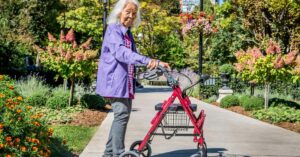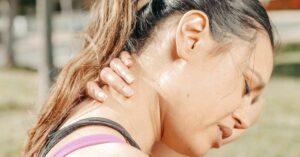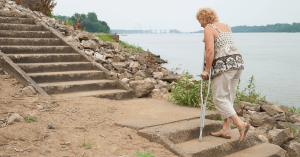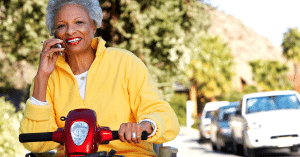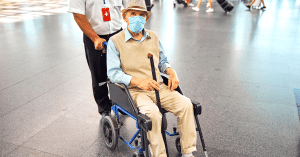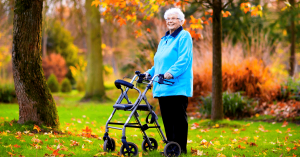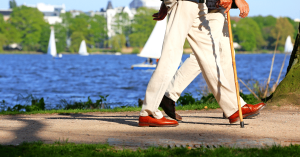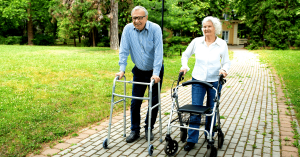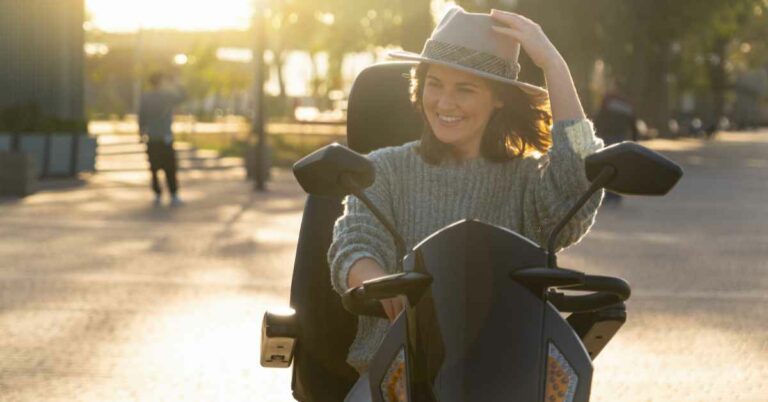
Are you struggling to get about? Wondering whether you might need a mobility aid?
If so, check out the article below for the top signs that you may need a mobility aid.
These are the main signs that I’ve seen over the years working as a physiotherapist. See if any of them sound familiar to you!
Table of Contents
Toggle1. Falls
Are you falling over or almost falling? If so, this is one of the biggest signs that you may need a mobility aid.
A mobility aid may help you to reduce your falls risk [1] and risk of sustaining a serious injury.
I say may be helpful because this is not always the case. It really depends on what’s causing you to fall over (or nearly fall over) in the first place.
If you’re having mechanical falls, meaning you’re falling over because you’re tripping over something or losing your balance or because your legs are weak and give way then an aid could help.
If you’re falling over for other reasons such as feeling dizzy, suddenly blacking out, getting chest pain or can’t see properly then a mobility aid is unlikely to make a difference. In these cases you need to get checked medically to see what’s causing this to happen.

2. Fatigue/exhaustion
Are you feeling exhausted all the time? Too fatigued to do more than the minimum?
If so, having the support of a mobility aid to lean on, or to help you get places, can make a massive difference. It can help take some of the strain out of day-to-day life.
Some walking aids like sticks and walkers even have seats attached so that you can take a break whenever you need to.
And wheelchairs and mobility scooters can help you conserve energy throughout the day so that you have enough energy left for your priorities [2].
3. Pain
Are you in pain? Either because you’ve recently hurt yourself or because you’re always in pain? And is this pain making it difficult for you to get around?
A mobility aid can help in various ways. A stick or crutch can help to take some weight off a painful joint so there isn’t so much load going through the painful area, for example with knee or foot pain [3].
Alternatively, a customised electric wheelchair can help you get comfortable and hold you in a well supported position whilst you get out and about and on with your day, regardless of your pain levels.

4. Breathlessness
Are you struggling with walking due to breathlessness? Do you have a long term condition where your breathing stops you from doing things?
Some mobility aids can help to reduce how much effort breathing is for you when walking.
For example, sometimes supporting your arms on a walking frame can help to stabilise your shoulder girdle, reducing respiratory effort [4].
Obviously, make sure to get checked by your doctor if you don’t know why you are breathless.

5. Fear of walking/going out
Are you fearful of going out or even just walking around the house in case you fall over? Have you had near misses and now you fear you could trip over or lose your balance and really hurt yourself? This is fairly common [1].
The right mobility aid for you can make a big difference in terms of safety but also confidence to get mobile again.
A mobility aid like a stick or a walker can help you balance when you feel unsteady – like when walking on uneven pavement slabs.
If you haven’t already, try to get a falls risk assessment from a physiotherapist – they will be able to help you figure out what might be causing you to fall and help you build your walking confidence back up.
6. Tripping over
Are you tripping over a lot? Catching your toes on rugs or steps or paving slabs?
This is another one of the big signs that you may need a mobility aid.
Tripping over is normally due to one of two things. Either you’re not lifting your feet or legs up quite high enough when stepping or your eyesight is affecting your ability to spot hazards/obstacles. Or both!
I suggest getting your vision checked at the opticians first to see if this is contributing. Also, sometimes wearing varifocals can contribute to tripping/falls.
The other important thing to do is to see a physiotherapist to assess your leg muscle strength – if there is weakness there, exercises to strengthen your muscles may help to reduce the tripping [5].
Mobility aids can help to steady you if you trip and lose your balance and so are useful for this reason. But best to figure out the root cause of the tripping to stop it happening in the first place.

7. Weakness
Do your legs feel weak and wobbly? Are you worried about them giving way when you are standing and walking?
Unless you are exercising regularly, muscles can get weak very quickly. If the thigh muscles (quadriceps) are weak you can find it hard to keep your legs straight when standing, which can cause your knees to give way [6].
Likewise, if your hip flexor muscles or shin muscles are weak you may find yourself catching your toes on things and tripping.
Mobility aids can help to support and stabilise you if you feel weak and wobbly on your feet. But you also need to try to strengthen your leg muscles with exercises.
8. Losing balance/dizziness
Are you losing your balance (or almost losing your balance) when standing or walking?
This is a big sign that you may benefit from a mobility aid. It’s important to firstly rule out medical reasons for this though.
For example. inner ear problems, blood pressure issues, vision problems and taking lots of medications can all cause loss of balance or dizziness. [7] Like feeling dizzy when you get up too quickly.
If your doctor clears you of medical causes, mobility aids like sticks and walkers help lots of people with reduced balance to feel safer and steadier.
Also, you can improve your balance with the right balance exercises so don’t feel that once your balance deteriorates it can never get better again – it can!

9. Loss of sensation
Have you got sensation problems that are affecting your walking?
If you are diabetic or have a neurological condition you might find that you can’t feel the ground properly with your feet due to loss of sensation.
This can lead to problems like tripping or taking excessively high steps because you’re not quite sure where the ground is [8].
Using a mobility aid such as a cane can sometimes help with these types of problems as you receive sensory feedback between the ground and your arm through the cane.
10. Staying in just in case
Have you found yourself staying indoors lately because it feels too risky to go out? Or are you lacking the motivation to go and do your usual activities?
Sometimes these things can sneak up on us and then we realise that we haven’t left the house for a few days.
Losing confidence with getting out and about with increasing age or decreasing mobility is common.
But it doesn’t have to be that way – the right mobility aid can help with mobility and confidence and getting back to an active lifestyle.
11. Recent injury protection
Have you recently hurt yourself and now you’re having trouble getting about? Sprained your ankle and hobbling around the house, for example?
Sometimes using a mobility aid short term to protect an injury and allow it to start healing can be useful [9].
For example, using crutches for a few days after a bad ankle sprain to take some weight off it.
Just make sure that you get your injury checked out to make sure it’s nothing more serious, especially if you’re still needing those crutches after a few days.

12. Losing your independence
Are you finding that you are relying on others more to get out and about? Do you find yourself stuck inside waiting until someone is free to go outdoors with you?
If this is you, you have options!
There are a wide range of mobility aids such as walkers and mobility scooters that can help you stay independent so you can keep doing what you want to do when you want to do it!
So there you have it – the 12 main signs that you may need a mobility aid.
Could you relate to any of the signs? If so, now might be a good time to get a mobility assessment from a physiotherapist.
They will be able to give you individual advice on whether you could benefit from a mobility aid.
It could mean you no longer have to worry about hurting yourself or being stuck indoors!
What to do next?
If you think you may need a mobility aid, but are not sure which one – please give my quiz a go:
Which mobility aid is right for you? – QUIZ
If you think you might need a walker or rollator but aren’t sure which one, please try out my other quiz to get a personalised recommendation:
Discover which walker or rollator is best for you – QUIZ
Why not find out more about the different types of aids available:
References
[1] Bauman CA, et al. (2014). ‘Community-based falls prevention: lessons from an Interprofessional Mobility Clinic’. Journal of the Canadian Chiropractic Association. 58(3): pp. 300-11
[2] Vatwani, A & Margonis, R (2019) ‘Energy conservation techniques to decrease fatigue’. Archives of Physical Medicine and Rehabilitation. Vol 100, issue 6, pp 1193-1196
[3] Simic, M et al (2011) ‘Contralateral cane use and knee joint load in people with medial knee osteoarthritis: the effect of varying body weight support’. Osteoarthritis and Cartilage. Vol 19, Issue 11, pp. 1330-1337
[4] Bolzani A et al (2017) ‘Physical interventions for breathlessness in adults with advanced diseases’. Cochrane Database Systematic Reviews. Jun 21;2017(6):CD012684.
[5] Pijnappels M et al (2008) ‘Tripping without falling; lower limb strength, a limitation for balance recovery and a target for training in the elderly’ Journal of electromyography and kinesiology 18, pp 188-196
[6] Ahmadiahangar, A. et al. (2018) ‘The role of quadriceps muscle strength in the development of falls in the elderly people, a cross-sectional study’. Chiropractic and Manual Therapies 26, article no. 31.
[7] Zaninotto, P. et al. (2020) ‘Polypharmacy is a risk factor for hospital admission due to a fall: evidence from the English Longitudinal Study of Ageing’. BMC Public Health 20, 1804.
[8] Reeves ND, et al (2021). ‘Sensory-Motor Mechanisms Increasing Falls Risk in Diabetic Peripheral Neuropathy’. Medicina (Kaunas). 8;57(5):457
[9] Dubois B, Esculier J-F (2020) ‘Soft-tissue injuries simply need PEACE and LOVE’ British Journal of Sports Medicine Vol 54 No 2

